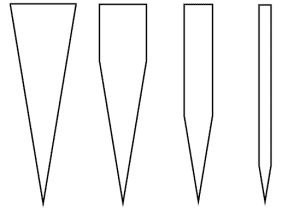In a hurry? Our top pick is MAC Traditional Nakiri 6.5″. It’s a vegetable-chopping machine and a crowd-pleaser that won’t break the bank.
Looking for the best nakiri knife in [year]? Overwhelmed with endless choices? You probably fell down the rabbit hole of no return. Worry not, I got you covered.
As an avid nakiri fan, I spent a couple of days researching 16 options and reading over 11 expert opinions. Then I baked you this guide to satisfy all needs, budgets, tastes, and skill levels.
N.B. If you are still hesitant about whether to buy a nakiri or not check our article here.
We review products independently, but we may earn affiliate commissions from buying through links on this page as an Amazon Associate.
Top 7 Best nakiri knives in [year]
- MAC Series 6 1/2-Inch Japanese Vegetable Cleaver
- Shun Premier Nakiri Knife, 5.5 TDM0742
- Wusthof Classic 7-Inch Nakiri Knife
- Kai Wasabi Black Nakiri Knife
- Moritaka AS Long 180mm Nakiri Knife
- Yoshihiro VG-10 16 Layer Hammered Damascus
- Tojiro Shirogami ITK Nakiri 165mm
Best Nakiri Knife reviews
Here’s our list of best choices that meet all various needs.
Whether you are a home cook or a prep cook, this bad boy will give you the performance of a high-end nakiri without burning a hole in your pocket. It’s our favorite option under $100.
No wonder that Wirecutter’s top pick of chef knives has been a Mac product since 2013. MAC Traditional Nakiri 6.5″ is also the best-rated Nakiri knife by America’s Test Kitchen.
This bad boy is a Japan-made stamped knife. Its blade features stain-resistant Molybdenum alloy steel with Rockwell 58°-59 and 15° blade angle.
Out of the box, this beast is sharp enough to shave hair. It takes and holds its keen edge for a longer time. As a result, you will need less frequent sharpening.
To test this Nakiri knife, I used it to make mirepoix (soffritto). I’ve sliced, diced, and chopped onions, carrots, and celery. The Japanese vegetable knife glided through the stuff with that nice SHHHWICK sound like butter. It has even halved butternut squash with ease. It didn’t splinter or tear any of the ingredients.
Yet, with starchy veggies like potatoes, the slices stuck to the knife. To be honest, it wasn’t a big concern to me, especially at this price point.
It’s super-light (5.4 ounces) making it best for those who suffer from arthritic hands. Besides, it is thin behind the edge with a 2.5 mm spine thickness. It’s beveled on both sides ( double bevel). So it is well suited for right and left hands.
This veg cleaver has a great balance towards the tip with a light handle and a hidden tang. Yet, it lacks a bolster, but as long as you use the pinch grip, it isn’t a problem.
In short, this thing is easy to handle and control.
The Mac Nakiri carries a 25-year warranty. However, it needs more TLC unless you will get numerous rust spots all over the blade. So, wash your knife manually with water and soap after using it. Put it under water after cutting acidic foods like citrus, and tomatoes. NO DISHWASHER. Don’t air dry, use your hands instead. Store it properly. It’s that simple!
Do this wisely and it will give you many years of happy use.
The fit & finish was my biggest pet peeve in that knife. There is a small gap between the blade and handle where food and water can find their way through. You need to squeeze a few drops of glue, or epoxy into this gap.
The spine was quite rough. So, you need to sand the back of the knife OTHERWISE you will end up with blisters.
It comes with a beautiful Pakkawood handle which will nestle comfortably at your hand
This beast outperformed a lot of my $300 knives. This exceptional performance at this price is a bargain.
Pros
- Best value.
- super-sharp with great edge retention.
- Great performance
- Easy to maneuver and control
- Ergonomic ambidextrous handle.
- 25 years warranty
Cons
- The Fit and finish is meh.
- Needs extra attention to protect the blade against staining
If you don’t want to fuss with the sharpening and the chore of maintaining high-carbon steels, that’s the ticket. The knife is perfect for any home cook regardless of his skill level and is highly recommended for vegans and crossfitters.
Sharpness
The core steel of this baby is VG-MAX (an upgrade of VG-10). That means this knife takes and retains a nice edge.
From Seki city in Japan, the blade comes incredibly sharp with a 61 HRC score. Shun also offers a free lifetime sharpening to your knife. You will only pay for shipping and processing. So, you don’t have to worry about the sharpening anymore.
Cutting food
I’m really surprised by the performance of this baby. The 5.5-inch agile blade drops through food like nothing. It will chop leafy lettuce, kale, and spinach all by itself without sending stuff flying off the cutting board.
The standout feature of stainless steel is that you don’t get the rapid oxidation or reactivity of tomatoes and onions. It made the job of slicing tomatoes like a child’s play. It’s finely diced onions and minced herbs into precise even cuts.
The knife is laser-ish with 1.9 mm spine thickness. I haven’t had any wedging or tearing issues using this blade.
The Shun Premier features a flat profile with a blunted tip. The rounded tip allows for a slight rocking motion in case you like rock chopping.
This little thing is well-balanced with more weight towards the blade for powerful cuts. The textured blade reduces the drag and helps against food sticking.
Comfort
Shun Premier from Kai is light weighing 5.9 ounces. It’s easy on the hands. It also features a curved bolster to get you a secure grip.
Besides, the handle is shorter and smaller than the Classic version making it perfect for ladies and people with small hands. Yet, if you have larger hands, the Shun Classic Nakiri is a perfect choice.
Unlike the Shun Classic nakiri knife, the Premier’s handle is ambidextrous.
Durability
High-carbon stainless steel is a breeze to maintain. Yet, VG-Max steel tends to be brittle and chippy.
The good news here is that if you’re a bit mindful of your knife, it will live to tell the tale. The lifetime warranty from Shun is a plus.
Fit and Finish
This baby is an eye candy.
The knife comes mirror-polished with 68 micro-layers of hand-hammered Damascus steel…
This Japanese veg cleaver boasts an oval sleek ebony pakkawood handle with a walnut finish.
Cost
Although I appreciate the work that was put into this baby, IMO, it is quite pricey.
Bonus tip: If you’re searching for a nice gift for those SPECIAL people in your life, this knife would make a nice gift. They won’t stop flaunting it ( in a good way). For gift bag size, the knife comes in a black box with 15”x3”x1 1/8” inches.
Pros
- Keen nimble blade out of the box.
- Great precision
- Less food drag and friction
- Comfortable grip ( for smaller hands)
- Free sharpening service.
- Lifetime warranty.
- Beautiful to behold.
Cons
- Delicate
- Expensive
- No sheath
If you’re coming from German kitchen knives background with a heftier and robust feel, this knife will fit the bill.
The pioneer woman, Ree Drummond, loves and recommends this western-style knife. That was enough to add it to our list. Yet, it proved it deserves this spot well.
The Wusthof Classic Nakiri Knife is made in Solingen, Germany from high carbon steel (x50 Cr Mo V15). The long straight blade steel was hardened to 58 HRC with Precision Edge Technology with a 10° blade angle. This technology yields a 20% sharper blade with 2x edge retention.
That said, this forged knife’s factory edge comes razor-sharp. However, this kitchen knife dulls faster in the practical experience.
Moving along to the performance,
I prepped French onion soup to exercise it. This workhorse is a great performer. I’ve diced onion effortlessly with clean precise cuts. It will make your chopping, dicing, and mincing so much easier.
The hollow edge makes small air pockets between the products and the blade to push the food off. Combine that with The PETec and the tantalizing taper of cutting edge. The result is a no-stick blade with SUPERB food release.
The Japanese knife is well-balanced with a blunted tip. This allows you to utilize rock chopping motion.
These knives are on the beefier, heavier side of the nakiri knives. So, it showed some wedging during julienning carrots.
Comfort & Durability
Wusthof Classic Nakiri boasts a polyoxymethylene (POM), comfortable triple-riveted handle. It will give you plenty of knuckle room. POM will resist fading, cracking, and shrinkage.
The bolster (where the blade meets the handle) will secure your fingers. Besides, the limited lifetime warranty is a great bonus.
The knife will last long enough to pass it on as expected from a German-build quality.
The finish is in line with what’s expected from a reliable maker like Wusthof.
Pros
- German high quality.
- Razor-sharp.
- Clean cuts
- No-stick blade
- Rock chopping motion.
- Easy to maneuver
- Durable comfortable handle.
Cons
- No sheath(Saya).
- Needs frequent sharpenings.
- It causes some wedging for firm vegetables.
A beginner home chef or culinary student who wants to test-drive the profile?
Want a hassle-free knife without worrying about sharpening or maintenance? At $50 budget or less? This is the best nakiri knife under 50.

Off-brand knife? Hell NO, KAI is the parent of Kershaw and Shun cutlery knives.
The Wasabi Black Nakiri knife features a high carbon stainless steel blade (Daido 1K6 ).
The factory edge is adequately sharp for home users. The edge retention is better than the softer German steel. That was a big surprise for me.
You’ll feel the thinness ( tapering from 5 mm to 1.8 mm) and lightness ( 4.8 ounces) of the Japanese nakiri Knives. The nakiri vegetable knife is blade-heavy with a light handle.
The stamped knife has no problem with dicing, brunoising, julienning vegetables, and fruits.
Another big surprise, it minces delicate herbs without bruising and oxidation. Tbh, it did a little bruising to the basil. Still great!
Wasabi has a polypropylene ( hard plastic) matte-black handle. It is mixed with bamboo powder and an antibacterial agent to ensure you get clean food preparation.
Being said, it is super-practical and comfortable to use with a Japanese shape. It’s perfect for the pinch grip. Yet, it may be a little bit slippery. So, watch out for your fingers.
The Kai knife might be a plain jane in terms of beauty. But who cares at this price point?
This nakiri vegetable knife could develop rust spots and a slightly tarnished appearance. Bar Keeper ( or any other rust eraser) will be your friend to remove the rust if it happens. Again, you need to be careful with this knife to avoid that.
The knife is dirt-cheap and it will only cost you a fraction of what a high-end brand does. It’s a joy to have it on your counter.
Pros
- Inexpensive
- Speed demon
- Noobies-friendly
- Takes a razor-sharp edge.
- Easy on the hands.
- Suitable for lefties.
Cons
- Develop rust spots
- Caused some wedging and sticking issues.
- Slippery handle.
- Have a cheap feeling.
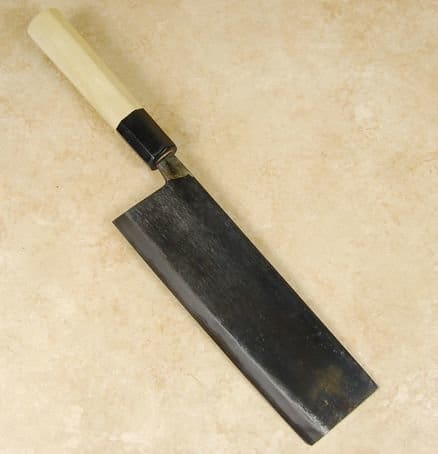
5. Moritaka AS Long 180mm Nakiri Knife Review -Best carbon steel nakiri
If you’re a pro cook who wants a high-end versatile carbon-steel nakiri knife, that’s a prep workhorse. It will save you a lot of time processing tons of vegetables on your prep list.
It’s the LOOK and FEEL of a killer handmade blade thanks to the 27th generation blacksmith Tsunehiro Moritaka.
Am I exaggerating? Maybe. I’ll let you judge by yourself.
Sharpness
The highly-regarded Aogami Super steel has been aggressively heat-treated to 64-65°. So, ootb, Moritaka comes with a SCARY SHARP edge that will stay sharp for a crazy long time.
Cutting foods
The forged nakiri knife with 7.1 (182 mm) inches is the longest and the flattest ( with no belly) between our picks. Combine that with its relative heft (6 ounces) and the distal taper ( from 3.1mm to 2.5m). Thus, it can cut long and thick vegetables with the precision of a scalpel.
Moritaka AS long nakiri is well-balanced. It’s blade-heavy. This translates to more control and comfort.
This veg nakiri knife passed all my knife tests. It sliced straight through the printer paper. It glides through starchy vegetables with no wedging or sticking making precise sheet-thin slices.
Onions? Tofu? Carrots? Tomatoes? Or even butternut squash? Moritaka will slice, chop, dice, brunoise, and julienne every single piece of produce.
Comfort
The knife features a super-light wood octagonal handle. It feels great in your hands. It’s also suitable for both righties and lefties.
It has the widest blade among other contenders (60 mm). This will give you plenty of knuckle clearance with a non-abrasive spine. After one hour of prep, it stayed pretty comfortable as the first touch.
Durability
Both the core steel and clad are reactive. So it’s more susceptible to rust. As a result, it needs some level of care, especially with acidic vegetables.
So avoid hard and frozen foods, and dry it after every use, and you will be golden.
NB: The knife boasts a stainless steel tang to enhance corrosion resistance. That’s the main reason for the color change right above the handle.
Fit & Finish
This vegetable cleaver is aesthetically surreal with a minimalistic mahogany-wood handle and the Kurouchi rustic finish.
This finish differentiates this model from the Ishime line with a tsuchime finish.
Besides, the blade and spine are smooth and straight with engraved elite Kanji.
Cost
The Moritaka Nakiri knife is pretty reasonably priced for what it offers. It’s the best nakiri knife under 200 in the high-carbon category.
Pros
- A keen agile edge that will last longer.
- Epic performance
- Ambidextrous ergonomic handle.
- Corrosion-resistant kurouchi finish.
- Nice fit and finish.
- Easy to resell.
Cons
- All-reactive steel blade that needs more care.
- The finish wears off quickly.
If you’re an entry-level chef who works in a “turn and burn ” restaurant with heavy production and a lot of greens prep with no time for maintenance, this is yours.
Yoshihiro comes with VG_10 WELL-MADE core steel with 60 HRC. The high carbon stainless steel is peace of mind to maintain. You only need to hand-wash it and sharpen it with a good whetstone.
Sharp? OOTB, the blade edge is razor-sharp. This bad boy takes and holds a very fine edge for a long time compared to other VG-10 knives. That is what I meant by “well-made steel”.
It glides through every type of vegetable easier than a hot knife through butter. It’s a solid performer. No matter whether the vegetables are hard or crispy, seedless or leafy, it will do the job as it Should.
This forged knife has a nice almost neutral balance with full tang extending through the handle. This makes it easy to control and manage. Besides, it is thin behind the edge with a spine (2.45 mm). So you can use it for precision cuts.
The food releases smoothly, thanks to the hand-hammered finish, nice grind, and decent blade geometry.
The knife is substantial in a Good Way. The type of heft (6.6 ounces) that’ll allow you to cut dense-root and hard vegetables without having joint soreness.
The Western-style handle nestles comfortably in your hand.
When I saw the mirror-polished hand-hammered finish, I was afraid to use it.
That’s a totally handcrafted knife in Japan not mass-produced. Beware of running this finish on a honing rod. The 16-layer Damascus steel clad with the Mahogany wood handle adds more beauty.
It is not the kind of knife that “grew legs and walked away”. It’s a lifetime investment.
The only drawback is that the bolster has a rough and sharp finish. So you need to touch it with sandpaper if you use the pinch grip.
Oh, I forgot to say, it is a right-handed knife.
Pros
- Handcrafted in Japan
- Ready to use out of the box.
- Superior performance.
- Easy to use and maintain.
- Aesthetically appealing.
- Great durability.
Cons
- Poorly finished bolster.
- Not suitable for left-handed people.
- Not fully waterproof handle
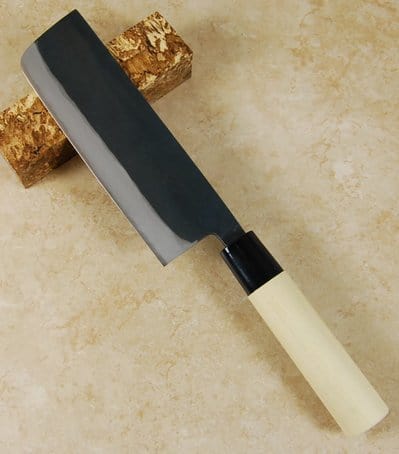
7. Tojiro Shirogami ITK Nakiri 165mm-best carbon steel nakiri under 50
This knife is a great introduction to Japanese carbon steel. You will learn how to care for and sharpen those types. I recommend it to any beginner knife hobbyist on a budget whether you’re a novice chef or a knife-obsessed home cook.
The blade edge, out of the box, is reasonably sharp. It might need a couple of strokes on the stones which is a nice opportunity to learn. Relax! It’s one of the easiest steels to sharpen.
Tojiro itk 165mm nakiri has White #2 (Shirogami) core. So, the knife takes a screaming edge and retains it well.
The vegetable knife has a 60 HRC rating which means it could chip easily if you mistreated it.
It is the lightest among our choices at 4.6 ounces, but also the thickest(3.7 mm at base). As the blade tapers to 1.5 mm at the middle. Then, the thickness is a blessing protecting your finger pad rather than a curse.
Itk has a neutral balance and a rounded tip making it more versatile. You can use pull or push chopping techniques.
It will chop, dice, and slice for daily salad-making or gourmet vegetable prepping.
The blade construction consists of 3 layers. The core steel is coated with soft iron steel for protection. So we’ve got her an all-reactive blade with no stainless on it. This means that it can rust easily, especially with acidic vegetables.
As a result, you have to wipe it down frequently with a terry cloth and paper towel. Use Camellia oil to coat the blade between meal prep.
This nakiri knife has a dark finish (kurouchi) to give you the rustic traditional Japanese lovely look. Expect the blade to patina (color change). This will protect the knife from corrosion a little bit.
The virgin nakiri has gaps between handles that you need to fill up with glue. You’ll also need to smooth the spine with sandpaper.
It comes with a D-shaped wa handle (Japanese). It’s well-suited for righties ONLY.
The Knife is affordable and will offer more than you pay for with a price tag under $50.
Pros
- Traditional Nakiri profile
- High carbon steel
- Easy to sharpen
- Versatile
- Lightweight and well-balanced
- Great value for money.
Cons
- All-reactive steel with a high tendency for rusting.
- Fragile.
- Fit & Finish needs some improvements.
- Right-handed only.
Nakiri Cutting Technique
Commonly, the Nakiri Knife isn’t rocker as the chef knife nor an axe like a Chinese chef’s knife. Unlike the all-purpose Santoku blade, nakiri knives are specialized in chopping vegetables.
Here are the major nakiri knife techniques that you need to learn.
#1. Push (thrust) cutting technique

You need to move the knife down and forward and keep it parallel to the cutting board.
2. Up and down cutting technique (tap chopping)

As the name suggests, you need to move the knife in up and down motion tapping on the cut surface.
#3. Rock cutting technique

This motion relies basically on a knife with a belly. The reason I included is that many knife makers increase the roundness of the nakiri tip to make it more versatile. IMO, the nakiri isn’t meant to do that.
How to Choose the Best Japanese Vegetable Knives?
Looking for a good nakiri knife? Shopping for knives could be an intimidating process. However, it all comes down to your personal preference, your budget, and your skill level.
Here’s your nakiri knife buying guide to choose the optimal option for you.
#1.Cutting Food
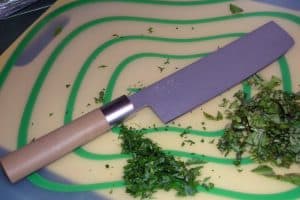
This is the bread and butter of a knife. There’s a multitude of factors that define the knife’s performance such as:
Balance
Balance means where the center of the mass is concentrated. Think of it as if you put the knife on your finger, where the knife will settle.
Knives are either blade-heavy neutral or handle-heavy. Always opt for a neutral or blade-heavy knife. Those are well-balanced knives.
Additionally, blade-heavy items will give you more powerful cuts. Yet, you might sacrifice with some precision using those blades.
All our picks in the list are either neutral or blade-heavy. We excluded any handle-heavy knives as their performance was subpar.
Food Separation
The thinness of the blade and the grind ( the shape of the blade cross-section) are the most significant over here. Knives with thick spines tend to have a V-shaped grind. As a result, they will cause wedging and tearing instead of slicing.
We found that the perfect blade width sets between 1.2 mm and 3.5 mm at the middle of the spine.
Food Release
This means that the food doesn’t stick to the blade after chopping. The blade finish plays a big role here. The knife makers have overcome this problem by using one of two modifications.
- Granton Edge (known also as a hollow ground edge)
It’s a series of dimples or scallops along the edge. These indentations form small air pockets between the blade and the slice. Then, the air breaks down the food’s water content allowing the food to release smoothly.
Wusthof Classic 7-Inch is our favorite hollow edge nakiri knife.
- Tsuchime ( hand-hammered finish)
This finish reduces the friction and drag when slicing food. Besides, other types of finishes help in food release to some extent.

Cutting edge Angle
A lower angle means more sharper blades. Although this allows for effortless chopping, it comes at the expense of durability.
The best nakiri kitchen knife generally falls between 8° to 16 degrees angle.
I found that 12 degrees and above is decent for newbies. No worries, you can modify this angle during the sharpening process.
#2.Blade length & size
Size always matters:D
This rule also applies here. The standout feature of the nakiri knives is that you use the entire blade length. But what’s the best size of a nakiri knife?
Well, it depends.
A nakiri bocho knife lengths range from 5 to 7 inches in most cases. So, they fall into 2 categories.
- Short nakiris ( 5 inches)
Short nakiris are perfect for the push-cutting technique as they’ll give you more control over the blade.
So, opt for a short nakiri knife if you have a kitchen with minimal space or you’re a beginner.
- Long nakiris ( 7 inches)
This type is well-suited for professional settings and tap choppers. The blade length will give you more mileage.
It’s also great if you want to cheat and use nakiri for everything.
#4.Sharpness
Sharpness hinges on the blade material (blade steel type). There are 2 basic types of steel based on the amount of carbon.
- High carbon _ Knives with high carbon steel tend to be harder. As a result, they’re way sharper and have great edge retention. They’re also easy to sharpen.
But, REMEMBER, a knife with pure high-carbon steel will rust and chip easily if you mistreat it.
- Low Carbon _ Low amount of carbon will give you a softer tougher knife. This means that you can avoid the microchip issues.
That also means it will dull faster and then you’ll need to sharpen it frequently.
Choose a knife with medium to high carbon stainless steel and you’ll get the best of both worlds.
Make sure that your chosen knife is sharp out of the box and ready to go. Sharp knives are capable of slicing straight-through paper. That’s how you can test them.
#5.Durability
Durability means how long your knife will live since its first use. It’s a blend of blade hardness and toughness as well as the handle material and the overall craftsmanship of the blade.
Steel Hardness
Steel hardness is measured by the Rockwell scale (HRC). Higher scores mean harder steel. High-quality hard steel( 64-65) is way more expensive than softer steel (53-55 ).
Look for Nakriris with above 58 HRC score and Bob’s your uncle.
Handle
The Pakkawood handle is my favorite. That’s because this wood/resin composite is waterproof, wear-resistant, and has less discoloration.
If the handle is not fully waterproof, it might contract or expand in various temperatures and humidity levels.
You might also choose between the wa handle (Japanese half-tang handle) or the Western handle. It’s totally up to you here.
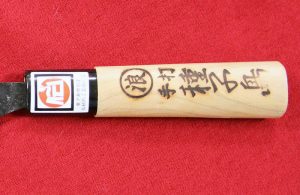
#6.Comfort
Comfort depends on many factors like the handle shape and finish as well as the total knife’s weight.
You should hold the handle and double-check that it’s smooth, not slippery, and comfortable to grip. Also, pay attention you have plenty of knuckle room during use.
Pinch-grip the knife and make sure that the spine or the bolster is curved or at least smooth. That will protect you from getting a callus on your index finger if you make a few big meals
Although nakiri knives are 40% lighter than other types with the same length, heavier blades will cause fatigue to your wrist in busy long shifts. So, that’s another metric to check.
I found that 4.5-6.7 ounces to be a happy medium between good heft needed for chopping and comfort needs.
#.7 Price
Please don’t skimp on your kitchen knives unless you’re planning to buy a beater knife. A decent nakiri will set you back from $80 to $300.
You can cap yourself at 50 bucks if you’re a noob who wants to play with the profile. Use the whole blade, learn push cutting, feel how much you like your first nakiri knife, and THEN you can upgrade.
Our Verdict
Nakiri knives are indispensable for chopping delicate vegetables. It will tackle all your veggies’ mise-en-place cutting tasks if you are a professional chef.
A stir-fry meal? A French soup? A salad for snacks? Easy as 1, 2, 3. For home users, it will speed up your meal prep time and turn your cooking chores into a joy.
We found MAC Traditional Nakiri 6.5″ to be an excellent choice. It will serve you well without being a burden on your budget.
More Japanese Knives coverage
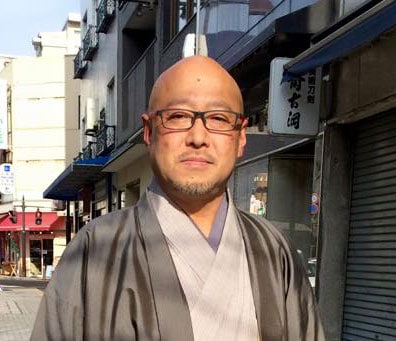
My name is Kenzo Kishita. I’m a retired cook and a knife nerd. Now I’m a full-time home cook and a passionate blogger. Here in the blog, I share with you my love for knives and cooking.






